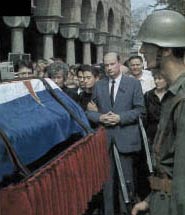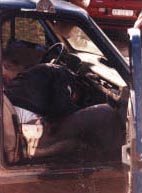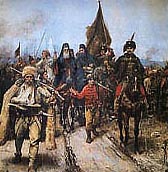
|
Albanian terrorism in Kosovo and Metohija is particularly appeared during the 19th century, when the Serbian population was reduced dramatically by physical liquidation, property seizures, and pressures leading to forced expulsion.
Current political and terrorist activities by ethnic Albanians in Kosovo and Metohija originated in the Prizren League program of 1878, which sought the union of all the Albanian populations dispersed on territories now within Albania, Greece, Macedonia, and Yugoslavia, and the creation of a Greater Albania. Today, this unity program defines the idea and political goal generally accepted by Albanian extremists. According to their interpretation, half of Albanian territory remains outside of Albania and, for decades, Albanians seeking unity in one state have presented themselves as a "threatened part of a nation" and strive to prove injustice. A precondition for the unity of all Albanians is ethnically pure territory. To that end, the Serbian and Montenegrin populations of Kosovo and Metohija have been subjected to systematic persecution and, under this pressure, continued emigrating out of the region into the 20th century. After World War I, ethnic Albanians formed the Kosovo Committee in 1918, and conducted terrorist activities with the goal of liberating Kosovo and other Albanian regions.
During World War II, a number of Albanian terrorist organizations in Kosovo and Metohija functioned in collaboration with fascist Italy and Nazi Germany. One of these organizations, Saban Poluza, continued its activities until 1951. During the 1960s, a number of illegal groups were formed, headed by the Revolutionary Committee for the Liberation of Albanians.
In 1974, the actions of the illegal Kosovo National Liberation Front were discovered. At the end of the 1970s, eight nationalist irredentist groups were discovered, indicating that Albanian subversive organizations were gaining strength.
During the 1980s, the Kosovo National Move- ment was formed through the merger of four political organizations: the National Liberation Movement of Kosovo and Other Parts of Albanian Yugoslavia, the Kosovo Marxist-Leninist Organization, the Communist-Marxist- Leninist Party of Albanians in Yugoslavia, and the Red National Front. These organisations will grow in 1990s into Kosovo Liberati- on Army.
 The particular target of their attack was the Yugoslav People's
Army. In the period from 1981 through 1988, 203 assaults and 311
threats were committed against members of the Yugoslav Army and
their family members, and there were 254 attacks against military
structures.
The particular target of their attack was the Yugoslav People's
Army. In the period from 1981 through 1988, 203 assaults and 311
threats were committed against members of the Yugoslav Army and
their family members, and there were 254 attacks against military
structures.
The most tragic event was the crime committed in the Army barracks in Paracin on the night of September 2, 1987, when the terrorist Aziz Keljmendi killed four soldiers in their sleep and wounded several others.
 On July 2, 1992, Albanian separatist leaders declared the existence
of "Kosovo Republic". Since 1991, Islamic influence has become
increasingly significant in separatist and terrorist activity in Kosovo
and Metohija.
On July 2, 1992, Albanian separatist leaders declared the existence
of "Kosovo Republic". Since 1991, Islamic influence has become
increasingly significant in separatist and terrorist activity in Kosovo
and Metohija.
During the 1990s, the Kosovo Liberation Army has become increasingly active in organizing terrorism. It first announced itself in public by sending written confirmation of its existence to the editorial offices of Albanian language newspapers in Kosovo. This organization sent a letter with similar contents to the editor of "Deutsche Welle" on June 20, 1996.
|
[ Home | Encyclopedia | Facts&Figures | News ]
Copyright ©1998 Ministry of Information
 PAJA JOVANOVICH
PAJA JOVANOVICH